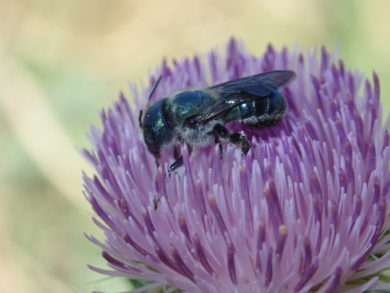
© madfox
Occurrence Status: One of the rarest bees in Vermont, known from only two specimens 41 years apart. A very small number probably persist in the Champlain Valley, and perhaps elsewhere. This species is a thistle (Cirsium) specialist, but occasionally visits other Composites. This species has been found to primarily nest in abandon nests of Anthophora in clay banks (Cane et al 2007). In Vermont, Anthophora bomboides is the only Anthophora species thought to nest in clay banks, which may further limit the distribution of Osmia texana.
Identification: One of only a few Osmia active mid-summer, a medium-large, deep blue bee. Females have black scopal hairs and large protrusions from the front of the mandibles. Males are probably not identifiable from photographs.
Similar Species:
Georgia Mason Bee (Osmia georgica): Also a composites specialist with protrusions on the mandibles, but females have pale scopal hairs. Uncommon, and active slightly earlier than O. texana.
Steel Blue Mason Bee (Osmia chalybea): A very similar southern thistle specialist. Unlikely to occur in Vermont, as the nearest record is from Long Island, NY.
Distribution: This is primarily a western species, with the first known VT (and New England) record collected July 9th 1979 by G. Tenwilliger in Centennial Woods. To see the global distribution, check out the iNaturalist account, and toggle the GBIF layer on the map.






